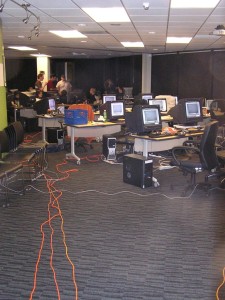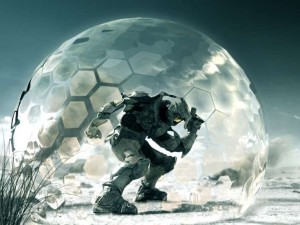 Ah Peter… I see you like making a statement. Awesome, this blog is a mix of all our opinions, and you’ve done a good job of backing up your own point of view. I’m not particularly suprised about your reaction to Halo’s health mechanics though… You’re an old-school online gamer, forged in the searing online fires of Mount Quake.
Ah Peter… I see you like making a statement. Awesome, this blog is a mix of all our opinions, and you’ve done a good job of backing up your own point of view. I’m not particularly suprised about your reaction to Halo’s health mechanics though… You’re an old-school online gamer, forged in the searing online fires of Mount Quake.
In contrast, as I’ve stated before, I like to play shooters (starting with Doom and its awesome shotgun) balls-out fearless, working out interesting ways to leap into the fray and rely on guts and skill to get the job done. Sure I like sessions of strategy too, but there are times where I just enjoy acting like a hero and being rewarded as such. I don’t even mind getting mowed down in tragic fashion if it’s due to my bravado. Such an approach does play havoc with my survivability in certain online contests (notably against Mr. Carlson), but I have fun doing it nonetheless.
The classic 100% health model, however, played a bit at odds with my play style. For me, each room or area of Doom is a fairly self-contained challenge, but upon completion I might have lower health than is practical to move onto the next session and still survive… you can’t always rely on the placement of health kits to get you back up to snuff. I’d often load up a save and try to get through that area with more health. This honed my skill and let me practice new ways of clearing a room, but as time went on, I found myself starting to play the game very “safe”… luring enemies around corners, slowly harassing opponents and so on. Doom suddenly became a very slow game to me. I enjoy tactical exercises like Rainbow Six as much as the next guy, but it wasn’t what I was looking for in a classic action shooter.
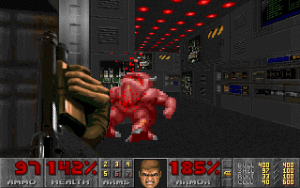 In 2001, however, that changed with Halo. By introducing shields that recharged once you remove yourself from immediate danger, it made my starting point for each challenge roughly the same. Suddenly, I could be heroic, and as long as I persevered, all was forgiven. Even sudden sneak attacks, where an enemy crammed into some unknowable corner got the drop on me, could be survived without excessive aggravation. I didn’t have to rely on reloads to teach me about each room. I still was “rated” on my progress by how much of my valuable ammo I used up, but by being encouraged to switch weapons on the battlefield quickly, I felt continuously propelled forward, ready to take the next challenge fully replenished.
In 2001, however, that changed with Halo. By introducing shields that recharged once you remove yourself from immediate danger, it made my starting point for each challenge roughly the same. Suddenly, I could be heroic, and as long as I persevered, all was forgiven. Even sudden sneak attacks, where an enemy crammed into some unknowable corner got the drop on me, could be survived without excessive aggravation. I didn’t have to rely on reloads to teach me about each room. I still was “rated” on my progress by how much of my valuable ammo I used up, but by being encouraged to switch weapons on the battlefield quickly, I felt continuously propelled forward, ready to take the next challenge fully replenished.
I would have thought Bungie’s reinvention of the classic health system to be one of the most shrewd, calculated design choices in recent history, but I am told that it was a bit more accidental, borne of the sci-fi setting and the expectations of having a “force field”. This is evidenced by the fact that Halo 1 still had non-regenerating “health” under all those shields, replenished at an incredibly stingy pace. Halo 2 ditched all that and went for a straight regen model, ditching “classic” health altogether and cementing regen as something of an industry-standard model, like WASD and Half-Life’s “directional damage” HUD.
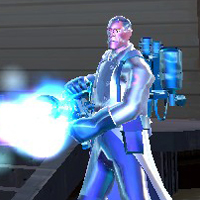 Other shooters adopted health regen in the meantime, like Call of Duty 2, Gears of War, and Blacksite: Area 51. Aside from the pacing differences, it was attractive because it eliminated the need to litter a battlefield with artificial constructs like easily-visible health packs (or worse yet, “food”). One would argue (Peter included) that surviving hundreds of bullets without tangible aid is unrealistic, but the regen model moves the issue behind the scenes, making the immersion a little bit stronger. In addition, health regen has invented a way to take a whole meter off the game interface, helping push forward a new generation of minimal-to-no-HUD games.
Other shooters adopted health regen in the meantime, like Call of Duty 2, Gears of War, and Blacksite: Area 51. Aside from the pacing differences, it was attractive because it eliminated the need to litter a battlefield with artificial constructs like easily-visible health packs (or worse yet, “food”). One would argue (Peter included) that surviving hundreds of bullets without tangible aid is unrealistic, but the regen model moves the issue behind the scenes, making the immersion a little bit stronger. In addition, health regen has invented a way to take a whole meter off the game interface, helping push forward a new generation of minimal-to-no-HUD games.
I certainly don’t consider the regen health model to be a panacea for all games. Multiplayer games have awesomely tense moments when one individual is reduced to low health and must either tough it out (e.g. in Counterstrike) or find a location or teammate to get healed up (e.g. in Team Fortress 2). You might consider it a bold evolution in shooters, but at minimum I don’t think anyone can argue that it’s not a great new tool for game designers to have in their gameplay toolbox.
Well, there’s my opinion. It’s ironic that I’m defending Halo since I’m not a particularly big fan of it… The second half of the first one was a slog for me, and Halo 2 seemed jumbled and punishing. I haven’t picked up the third one yet, so after I finish Bioshock (which will be after I get my poor, broken Xbox back from Microsoft) I’ll check it out. Perhaps we can get a post from a die-hard Halo fan, like Dan O?
[Ed: Check out Peter’s preceding article here.]
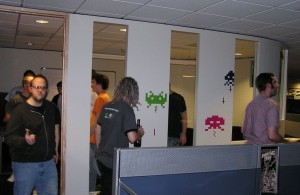
 This is all a warm-up, though, because across the Seattle area, the TF2 showdown has crossed studio boundaries in the Valve-hosted TF2 Studio Rumble 2007. So far Surreal has defeated two contenders, and unless Zombie pulls out an upset tonight, we’ll be going up against the dreaded forces of Valve itself next week. Wish us luck!
This is all a warm-up, though, because across the Seattle area, the TF2 showdown has crossed studio boundaries in the Valve-hosted TF2 Studio Rumble 2007. So far Surreal has defeated two contenders, and unless Zombie pulls out an upset tonight, we’ll be going up against the dreaded forces of Valve itself next week. Wish us luck!
